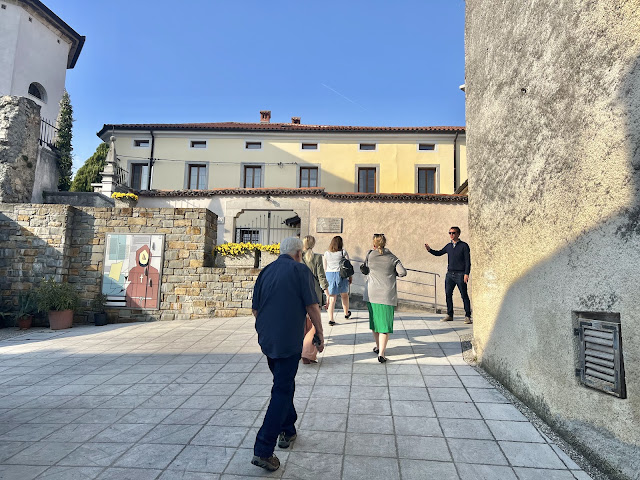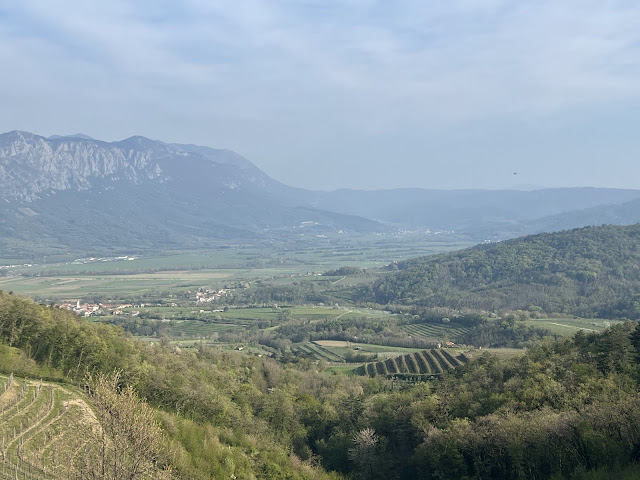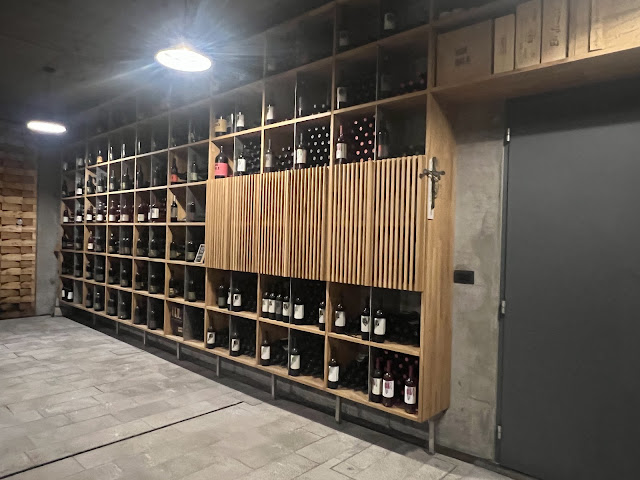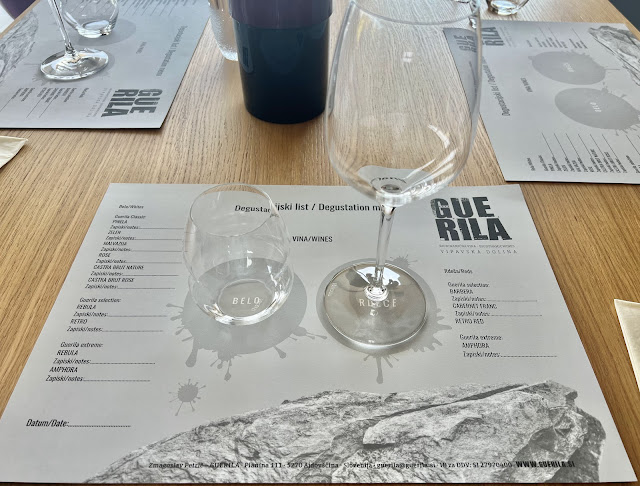Darovi Vipavske tasting room in Vipavski Križ, a scenic town on a hill near Ajdovščina in Slovenia's Vipava Valley was our second wine stop. Shortly after we arrived in Ljubljana, Slovenia I booked a Vipava Valley wine tour with Wine Express Tours. I was excited to visit the Vipava Valley (Vipavska Dolina), a wine region in Slovenia's western Primorski region, which has become known as one of the country's most successful viticultural areas.
Arriving in Vipavski Križ, Slovenia © Spaswinefood
Vipavski Križ, Slovenia © Spaswinefood
Exploring Vipavski Križ, Slovenia © Spaswinefood
Welcome to Vipavski Križ, Slovenia © Spaswinefood
Earlier, when we met at our pickup point in Ljubljana we joined four women from Finland. It was about a one and half hour drive to the Vipava Valley from Ljubljana. Our van driver who was also the tour leader gave us an overview of what to expect. As we drove to the wine valley our guide explained the major influences on the various regions of Slovenia. Along the way he would also pointed out significant sites, etc. It was a very relaxing spring time drive to the Vipava Valley; and where inspiring wine adventures waited for us.
Welcome to Darovi Vipavske Tasting Room, Vipavski Križ
After an exploratory walk, we were off to taste wines. I was excited to discover Darovi Vipavske tasting room in Vipavski Križ, a medieval town. One website described the town as the second smallest in the world. I have no idea if this description is accurate (second smallest town in the world) however, it is definitely a lovely small town. This is very inviting place, just check out its fascinating history and wine events (such as the Zelen Wine Festivall) held here throughout the year.
The scenic hillside town will catch your eye from afar. Perched proudly on a hill near Ajdovščina, Vipavski Križ used to be a very important town and the centre of the valley for centuries. The tiny, picture-book town with an impressive wall is one of the finest monuments of cultural history in the country.
There are some places that catch your immediate attention, and Vipavski Križ is one of those.
Vipavski Križ, Vipava Valley, Slovenia © Spaswinefood
Upon arrival we walked around the village, before stopping by Darovi Vipavske (a wine shop, wine bar, bistro, tasting room, and shop for local products).
Arriving at Darovi Vipavske © Spaswinefood
Once inside we sat around a wine barrel and explored Vipava Valley wines with Mirjana. I so enjoyed exploring wines made with indigenous Slovenian grapes, like Pinela and Zelen. In addition, we tasted Vipava Valley orange and amphora wines from different producers.
Wine Tasting, Darovi Vipavske © Spaswinefood
To go along with the wines we were served very tasty food platters.
Food Platters, Darovi Vipavske © Spaswinefood
I tasted an exciting lineup of Slovenia wines produced from indigenous grapes, and orange and amphora wines. In case you are wondering what are orange and amphora wines. Both of these wines are derived from ancient traditions. In the case of orange wine, sometimes called amber wine, it is a style of wine that is produced from white grapes. Specifically during the fermentation process the pressed grape juice has contact with skin and seeds. On the other hand amphora wine, is a wine fermented or aged in a clay vessel, such as a qvevri. This process can be used for any type of wine.
Yes, there was on display Simon Wolfe's book, The Amber Revolution, and we were told he visited there.
Memories of Darovi Vipavske © Spaswinefood
Amongst the wines we tasted there were a number of wines produced from Zelen, the indigenous grape, that I referenced earlier in this article. For example, Furlan, Zelen, Vipavska Dolina 2023 (see Vivino)
Furlan, Zelen, Vipavska Dolina 2023
Furlan, Zelen, Vipavska Dolina 2023 © Spaswinefood
It was a very lovely wine tasting at Darovi Vipavske.
While touring the village I noticed Vina Kovac sign.
Sign Spotting: Vina Kovac © Spaswinefood
All too soon, we left the Vipava Valley and headed back to Ljubljana.
Vipava Valley, Slovenia © Spaswinefood
Moreover, after visiting and reading about this historical town, Vipavski Križ it certainly makes me want to return. Besides falling in love with the town we left taking with us, those wonderful memories of the Vipava Valley landscape in the spring time.

Spring Time Vineyards, Vipava Valley © Spaswinefood
Vipava Valley amidst the picturesque Karst landscapes is where Mediterranean air meets the cold Alpine slopes. This is a region is renowned for its rich winemaking tradition and stunning natural beauty. As we drove through the valley we passed by villages, which were centered around church towers.
Taking in the Views, Vipava Valley, Slovenia © Spaswinefood
Vineyards were already showing signs of early spring growth.
Spring Time Flowers: Vipava Valley Vineyard © Spaswinefood
Slovenian Wine Country
Vipava Valley was my first introduction to Slovenian wine country. Slovenia has three wine regions. Vipava Valley is within one of these three, the Primorska wine region. There are no appellations within the Primorska region however, there are various districts where winemaking techniques and the wine produced differ. The winemaking districts of the Primorska wine region include Vipava, Slovenian Istra , Goriska Brda, and Karts. The Vipava area (3005 ha) is commonly known for producing light and crisp white wines made from Pinela and Zelen grapes. In addition, we were excited to discover its orange and amphora wines.
Vipava Valley (Vipavska Dolina) has been known as a wine-growing region for centuries. Not only has wine growing been deep-rooted tradition here but also, new innovations have also emerged. It is one of Slovenia's most successful wine regions. We visited a region with beautiful green rolling hills that benefit from good soils, a mild climate, and rain. Despite its distance from the coast, this region has a Mediterranean climate. Moreover, the Vipava River flows across the region, and onto the Adriatic Sea. Visitors to the Vipava Valley will experience quality Vipava wines, which are enriched by the sun and the bora wind. Yes, we heard about the strong bora winds that sweep through the valley.
The Vipava Valley, since Slovenia's independence in 1991, has experienced growth in its wine industry. It is a very dynamic wine region, with winemakers constantly experimenting with grape varietals and the winemaking process. In addition to successfully growing numerous well-known international wine varieties, it is also home to special grape varieties. These include: (1) the indigenous Zelen, which is very popular among the locals, (2) Pinela, an old wine variety, found only in the Vipava Valley, (3) Klarnica, a “boutique” wine variety, which has been revived again, and (4) other wine varieties.
Vipava Valley, Slovenia © Spaswinefood
By day's end we were impressed by Vipava Valley and its wines
. I am so glad that we had the opportunity to visit Darovi Vipavske, and our earlier stop at Guerila Wines. The
Vipava Valley Wine Express Tour From Ljubljana was a fabulous introductory tour for us. For those interested in trying Slovenia wines you can research their availability in the US at Total Wines and Vivino. I invite you to join me in my wine travels in Slovenia and elsewhere at Wine Travels with Dr. Sharon, and at Spaswinefood on Bluesky and Facebook. I am so looking forward to sharing more on my vine-filled explorations.
Cheers
Sharon
April 2025
Vipava Valley, Slovenia
© Spaswinefood
Darovi Vipavske in Vipavski Križ, Vipava Valley © Spaswinefood
Wine Travels in the Vipava Valley © Spaswinefood
Vipava Valley, Slovenia © Spaswinefood
Follow me on Bluesky and Facebook




































































